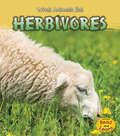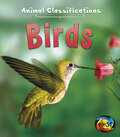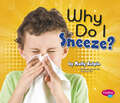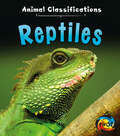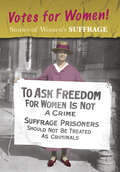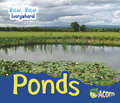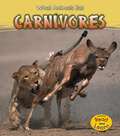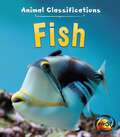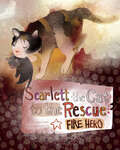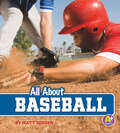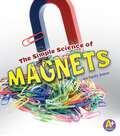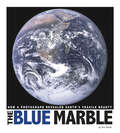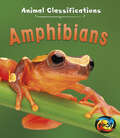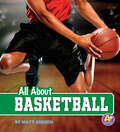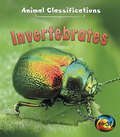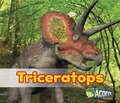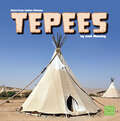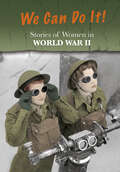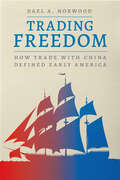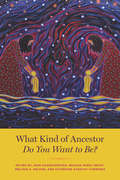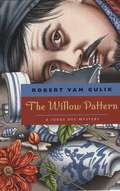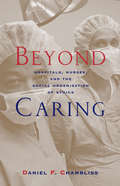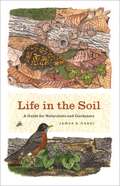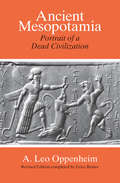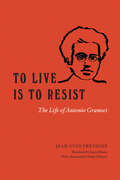- Table View
- List View
Herbivores (What Animals Eat Ser.)
by James BenefieldWhat do herbivores eat? Mostly food from plants! Find out what classifies an animal as a ‘herbivore,’ as well as how common features like tooth shape reflect an animal’s diet. Get and in-depth look at a wide range of fascinating animals from around the world and introduce readers to ideas about the relationships between animals.
Birds (Animal Classifications Ser.)
by Angela RoystonThis book is all about birds: what they do, how they behave, and how these characteristics are different from other groups of animals. Beautifully illustrated with colorful photographs, the book shows many examples of different types of birds in their natural environment.
Why Do I Sneeze? (My Silly Body Ser.)
by Molly KolpinAchoo! A sneeze can be loud, silent, or silly. Take a trip inside the nose to find out just what makes us sneeze. Colorful photo and diagrams and informative text show young readers what causes an itchy nose.
Reptiles (Animal Classifications Ser.)
by Angela RoystonThis fascinating series takes a very simple look at animal classifications, with each book focussing on a different group of animal. This book is about reptiles: what they do, how they behave, and how these characteristics are different from other groups of animals. Beautifully illustrated with colorful photographs, the book shows many examples of different types of reptiles in their natural environment.
Stories of the Struggle for the Vote: Votes for Women!
by Charlotte GuillainWomen used to have few rights. All the important decisions in their lives were made by men. They could not vote and give their opinion on who should run the country. By the middle of the 19th century, more and more women were starting to ask why not? These are the stories of five trailblazers who achieved amazing things in difficult circumstances: Elizabeth Cady Stanton began campaigning for women’s rights when she was refused entry to a convention because she was a women. Susan B Anthony cast her vote knowing she’d be arrested. Clementina Black organized a strike at a factory that paid women low wages. Carrie Chapman Catt travelled the world promoting the need for women’s suffrage. Emmeline Pankhurst led a march along Downing Street in London, petitioning the vote for women. Many of the rights women have today are down to their actions. They helped change society's image of women forever.
Ponds (Water, Water Everywhere! Ser.)
by Diyan LeakeIn this book, children learn all about ponds, including what ponds are like, what lives in ponds, how some ponds are made, and how to stay safe near ponds.
Carnivores (What Animals Eat Ser.)
by James BenefieldWhat do carnivores eat? Mostly meat! Find out what classifies an animal as a ‘carnivore,’ as well as how common features like tooth shape reflect an animal’s diet. Get and in-depth look at a wide range of fascinating animals from around the world and introduce readers to ideas about the relationships between animals.
Fish (Animal Classifications Ser.)
by Angela RoystonThis book is about all fish: what they do, how they behave, and how these characteristics are different from other groups of animals. Beautifully illustrated with colorful photographs, the book shows many examples of different types of fish in their natural environment.
Scarlett the Cat to the Rescue: Fire Hero (Animal Heroes Ser.)
by Nancy LoewenWhen her home in Brooklyn goes up in flames, brave Scarlett won’t give up until her kittens are safe. See the story unfold as Scarlett the fearless feline risks her life to save her family.
All About Baseball (All About Sports Ser.)
by Matt DoedenLots of kids want to know more about baseball, one of the most popular sports in the world. This fun, fan-friendly introduction to the sport will help them slide in for a look at what makes this sport so exciting. Readers will learn about the positions, rules, and much more.
The Simple Science of Magnets (Simply Science Ser.)
by Emily JamesMagnets have amazing power to make things move. But how do they work? What are they used for? Readers will learn the answers to these questions and more through easy-to-read text and vivid photographs. An experiment rounds out the book and provides a hands-on learning experience to encourage deeper understanding. Meets Next Generation Science Standards.
The Blue Marble: How A Photograph Revealed Earth's Fragile Beauty (Captured World History Ser.)
by Don NardoThe astronauts headed to the moon in December 1972 thought they knew what to expect. They would soon be exploring the moon’s surface. But what they didn’t expect came as a huge bonus. The astronauts of Apollo 17 would produce an amazing photograph of planet Earth—a lonely globe floating in inky black space. Their stunning Blue Marble image was destined to become one of the most reproduced and recognizable photos in history. And no one is 100 percent sure who took it.
Amphibians (Animal Classifications Ser.)
by Angela RoystonThis book is all about amphibians: what they do, how they behave, and how these characteristics are different from other groups of animals. Beautifully illustrated with colorful photographs, the book shows many examples of different types of amphibians in their natural environment.
All About Basketball (All About Sports Ser.)
by Matt DoedenLots of kids want to know more about basketball, one of the most popular sports in the world. This fun, fan-friendly introduction to the sport will help them dribble to the hoop for a look at what makes this sport so exciting. Readers will learn about the positions, rules, and much more.
Invertebrates (Animal Classifications Ser.)
by Angela RoystonThis fascinating series takes a very simple look at animal classifications, with each book focussing on a different group of animal. This book is about invertebrates: what they do, how they behave, and how these characteristics are different from other groups of animals. Beautifully illustrated with colorful photographs, the book shows many examples of different types of invertebrates in their natural environment.
Triceratops (All About Dinosaurs Ser.)
by Daniel NunnThis book takes a very simple look at the Triceratops dinosaur, examining what it looked like, what it ate, how it behaved, and its special skills and features such as the horns on its head. The book also discusses how we know about Triceratops today, showing where fossils are found and how scientists put them together.
Tepees (American Indian Homes Ser.)
by Jack ManningAmerican Indians used buffalo skins and other materials to build tepees. Learn all about tepees, including the tools used to build them and the people who called them home.
Stories of Women in World War II: We Can Do It! (Women's Stories From History Ser.)
by Andrew LangleyMore than 75 million people fought in World War II – nearly all of them men. Who was going to produce the weapons and the food, and do countless other vital jobs? The answer was women. Millions stepped forward to take on work they had rarely done before, such as fighting fires, ploughing fields and cracking codes. These are the stories of four trailblazers who achieved amazing things in difficult circumstances: Anne-Marie Walters became a secret agent in constant danger of being captured, working behind enemy lines in France. A painting of Ruby Loftus operating machinery became an iconic image of women’s contribution to the war effort. By the time Nancy Love was in her early twenties, she was one of America’s leading woman pilots. When “Red” Harrington and her fellow nurses were captured by the Japanese, they set up a hospital to look after the thousands of other prisoners of war. Many of the rights women have today are down to their actions. They helped change society's image of women forever.
Trading Freedom: How Trade with China Defined Early America (American Beginnings, 1500-1900)
by Dael A. NorwoodExplores the surprisingly rich early history of US-China trade and its unexpected impact on the developing republic. The economic and geographic development of the early United States is usually thought of in trans-Atlantic terms, defined by entanglements with Europe and Africa. In Trading Freedom, Dael A. Norwood recasts these common conceptions by looking to Asia, making clear that from its earliest days, the United States has been closely intertwined with China—monetarily, politically, and psychologically. Norwood details US trade with China from the late eighteenth through the late nineteenth centuries—a critical period in America’s self-definition as a capitalist nation—and shows how global commerce was central to the articulation of that national identity. Trading Freedom illuminates how debates over political economy and trade policy, the building of the transcontinental railroad, and the looming sectional struggle over slavery were all influenced by Sino-American relations. Deftly weaving together interdisciplinary threads from the worlds of commerce, foreign policy, and immigration, Trading Freedom thoroughly dismantles the idea that American engagement with China is anything new.
What Kind of Ancestor Do You Want to Be?
by Melissa K. Nelson John Hausdoerffer Brooke Parry Hecht Katherine Kassouf CummingsAs we face an ever-more-fragmented world, What Kind of Ancestor Do You Want to Be? demands a return to the force of lineage—to spiritual, social, and ecological connections across time. It sparks a myriad of ageless-yet-urgent questions: How will I be remembered? What traditions do I want to continue? What cycles do I want to break? What new systems do I want to initiate for those yet-to-be-born? How do we endure? Published in association with the Center for Humans and Nature and interweaving essays, interviews, and poetry, this book brings together a thoughtful community of Indigenous and other voices—including Linda Hogan, Wendell Berry, Winona LaDuke, Vandana Shiva, Robin Kimmerer, and Wes Jackson—to explore what we want to give to our descendants. It is an offering to teachers who have come before and to those who will follow, a tool for healing our relationships with ourselves, with each other, and with our most powerful ancestors—the lands and waters that give and sustain all life.
The Willow Pattern: A Judge Dee Mystery (The Judge Dee Mysteries)
by Robert van GulikJudge Dee has been appointed emergency governor of the plague- and drought-ridden Imperial City. As his guards help the city fend off a popular uprising, an aristocrat from one of the oldest families in China suffers an "accident" in a deserted mansion.In The Willow Pattern, the illustrious judge uses his trademark expertise to unravel the mysteries of the nobleman, a shattered vase, and a dead bondmaid. Along the way he encounters a woman who fights with loaded sleeves, a nearly drowned courtesan, and an elaborate trap set for a murderer. Packed with suspense, violence, and romance, The Willow Pattern won’t disappoint Judge Dee’s legions of loyal fans."The China of old, in Mr. van Gulik’s skilled hands, comes vividly alive again."—Allen J. Hubin, New York Times Book Review
Beyond Caring: Hospitals, Nurses, and the Social Organization of Ethics (Morality And Society Ser.)
by Daniel F. ChamblissVividly documenting the real world of the contemporary hospital, its nurses, and their moral and ethical crises, Dan Chambliss offers a sobering revelation of the forces shaping moral decisions in our hospitals. Based on more than ten years' field research, Beyond Caring is filled with eyewitness accounts and personal stories demonstrating how nurses turn the awesome into the routine. It shows how patients, many weak and helpless, too often become objects of the bureaucratic machinery of the health care system and how ethics decisions, once the dilemmas of troubled individuals, become the setting for political turf battles between occupational interest groups. The result is a compelling combination of realism and a powerful theoretical argument about moral life in large organizations.
Life in the Soil: A Guide for Naturalists and Gardeners
by James B. NardiLeonardo da Vinci once mused that “we know more about the movement of celestial bodies than about the soil underfoot,” an observation that is as apt today as it was five hundred years ago. The biological world under our toes is often unexplored and unappreciated, yet it teems with life. In one square meter of earth, there lives trillions of bacteria, millions of nematodes, hundreds of thousands of mites, thousands of insects and worms, and hundreds of snails and slugs. But because of their location and size, many of these creatures are as unfamiliar and bizarre to us as anything found at the bottom of the ocean. Lavishly illustrated with nearly three hundred color illustrations and masterfully-rendered black and white drawings throughout, Life in the Soil invites naturalists and gardeners alike to dig in and discover the diverse community of creatures living in the dirt below us. Biologist and acclaimed natural history artist James B. Nardibegins with an introduction to soil ecosystems, revealing the unseen labors of underground organisms maintaining the rich fertility of the earth as they recycle nutrients between the living and mineral worlds. He then introduces readers to a dazzling array of creatures: wolf spiders with glowing red eyes, snails with 120 rows of teeth, and 10,000-year-old fungi, among others. Organized by taxon, Life in the Soil covers everything from slime molds and roundworms to woodlice and dung beetles, as well as vertebrates from salamanders to shrews. The book ultimately explores the crucial role of soil ecosystems in conserving the worlds above and below ground. A unique and illustrative introduction to the many unheralded creatures that inhabit our soils and shape our environment aboveground, Life in the Soil will inform and enrich the naturalist in all of us.
Ancient Mesopotamia: Portrait of a Dead Civilization
by A. Leo Oppenheim"This splendid work of scholarship . . . sums up with economy and power all that the written record so far deciphered has to tell about the ancient and complementary civilizations of Babylon and Assyria."—Edward B. Garside, New York Times Book Review Ancient Mesopotamia—the area now called Iraq—has received less attention than ancient Egypt and other long-extinct and more spectacular civilizations. But numerous small clay tablets buried in the desert soil for thousands of years make it possible for us to know more about the people of ancient Mesopotamia than any other land in the early Near East. Professor Oppenheim, who studied these tablets for more than thirty years, used his intimate knowledge of long-dead languages to put together a distinctively personal picture of the Mesopotamians of some three thousand years ago. Following Oppenheim's death, Erica Reiner used the author's outline to complete the revisions he had begun. "To any serious student of Mesopotamian civilization, this is one of the most valuable books ever written."—Leonard Cottrell, Book Week "Leo Oppenheim has made a bold, brave, pioneering attempt to present a synthesis of the vast mass of philological and archaeological data that have accumulated over the past hundred years in the field of Assyriological research."—Samuel Noah Kramer, Archaeology A. Leo Oppenheim, one of the most distinguished Assyriologists of our time, was editor in charge of the Assyrian Dictionary of the Oriental Institute and John A. Wilson Professor of Oriental Studies at the University of Chicago.
To Live Is to Resist: The Life of Antonio Gramsci
by Jean-Yves FrétignéThis in-depth biography of Italian intellectual Antonio Gramsci casts new light on his life and writing, emphasizing his unflagging spirit, even in the many years he spent in prison. One of the most influential political thinkers of the twentieth century, Antonio Gramsci (1891–1937) has left an indelible mark on philosophy and critical theory. His innovative work on history, society, power, and the state has influenced several generations of readers and political activists, and even shaped important developments in postcolonial thought. But Gramsci’s thinking is scattered across the thousands of notebook pages he wrote while he was imprisoned by Italy’s fascist government from 1926 until shortly before his death. To guide readers through Gramsci’s life and works, historian Jean-Yves Frétigné offers To Live Is to Resist, an accessible, compelling, and deeply researched portrait of an extraordinary figure. Throughout the book, Frétigné emphasizes Gramsci’s quiet heroism and his unwavering commitment to political practice and resistance. Most powerfully, he shows how Gramsci never surrendered, even in conditions that stripped him of all power—except, of course, the power to think.
